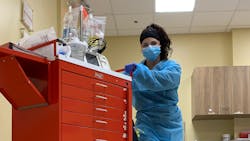CDC reports on COVID-19–associated hospitalizations among healthcare personnel
The Centers for Disease Control and Prevention (CDC) released a report on healthcare personnel (HCP) exposed to COVID-19, both within and outside the workplace, increasing their risk for infection.
Among 6,760 adults hospitalized during March 1–May 31, 2020, for whom HCP status was determined by the COVID-19–Associated Hospitalization Surveillance Network (COVID-NET), 5.9 percent were HCP.
Nursing-related occupations (36.3 percent) represented the largest proportion of HCP hospitalized with COVID-19. Median age of hospitalized HCP was 49 years, and 89.8 percent had at least one underlying medical condition, of which obesity was most commonly reported (72.5 percent). A substantial proportion of HCP with COVID-19 had indicators of severe disease: 27.5 percent were admitted to an intensive care unit (ICU), 15.8 percent required invasive mechanical ventilation, and 4.2 percent died during hospitalization. HCP can have severe COVID-19–associated illness, highlighting the need for continued infection prevention and control in health care settings as well as community mitigation efforts to reduce transmission.
COVID-NET conducts population-based surveillance for laboratory-confirmed COVID-19–associated hospitalizations among persons of all ages in 99 counties in 14 states. Hospitalized patients who are residents of the surveillance catchment area and have a positive SARS-CoV-2 molecular test result during their hospitalization or within 14 days before admission are included in COVID-NET. SARS-CoV-2 testing is performed at the discretion of health care providers or according to hospital testing policies.
Trained surveillance officers conduct medical chart abstractions for COVID-19 patients using a standardized case report form, which includes HCP status. Because of high case counts, nine of 13 sites conducted in-depth medical chart abstractions for an age-stratified random sample of all reported COVID-19 patients hospitalized during March 1–May 31.
Overall, 89.8 percent of HCP hospitalized with COVID-19 had documentation of at least one underlying condition. The most commonly reported conditions included obesity (body mass index ≥30 kg per m2) (72.5 percent), hypertension (40.6 percent), and diabetes (30.9 percent). Compared with HCP generally expected to have direct patient contact, those generally not expected to have direct patient contact had higher prevalences of obesity (80.9 percent versus 68.3 percent) and cardiovascular disease (excluding hypertension) (23.5 percent versus 8.4 percent). Among female HCP aged 18–49 years hospitalized with COVID-19, 9.6 percent were pregnant during hospitalization. Upon hospital admission, 96.6 percent of HCP reported COVID-19–associated signs and symptoms; shortness of breath (79.0 percent), cough (76.6 percent), and fever or chills (73.9 percent) were those most commonly reported.
The median length of hospitalization among HCP with COVID-19 was four days. COVID-19 investigational treatments were administered to 48.2 percent of HCP hospitalized with COVID-19. Overall, 27.5 percent of HCP were admitted to an ICU for a median of six days, and 15.8 percent required invasive mechanical ventilation. Pneumonia was a documented discharge diagnosis for 56.7 percent of HCP hospitalized with COVID-19 and acute respiratory failure for 42.9 percent. Sixteen (4.2 percent) HCP with COVID-19 died during hospitalization.
Findings from this analysis of data from a multisite surveillance network highlight the prevalence of severe COVID-19–associated illness among HCP and potential for transmission of SARS-CoV-2 among HCP, which could decrease the workforce capacity of the health care system. HCP, regardless of any patient contact, should adhere strictly to recommended infection prevention and control guidance at all times in health care facilities to reduce transmission of SARS-CoV-2, including proper use of recommended personal protective equipment, hand hygiene, and physical distancing.
Community mitigation and prevention efforts in households and congregate settings are also necessary to reduce overall SARSCoV-2 transmission. Continued surveillance of hospitalized HCP is necessary to document the prevalence and characteristics of COVID-19 among this population. Further understanding of exposure risks for SARS-CoV-2 infection among HCP is important to inform additional prevention strategies for these essential workers.
